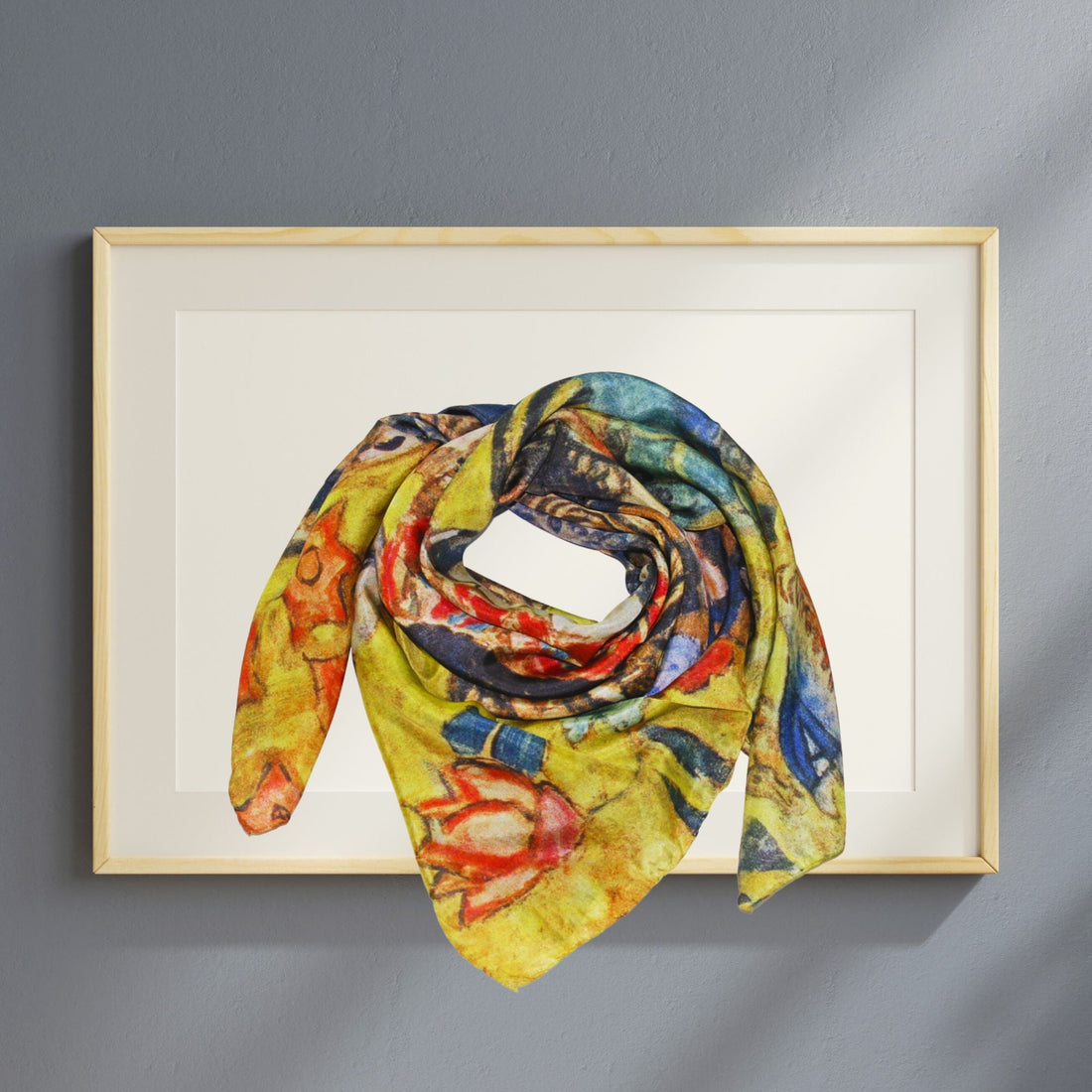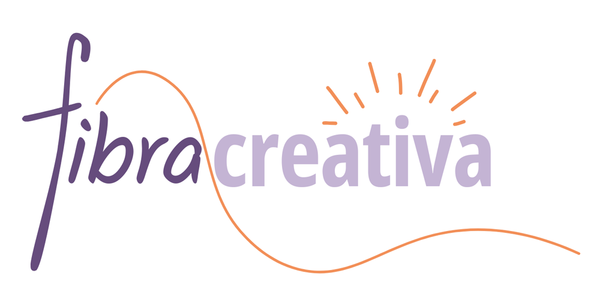
How to reproduce a painting on a silk scarf
Share
Professional or amateur painter, you would like to reproduce a painting on a silk scarf, to create quality merchandise from your works.
Mugs, caps, keychains, T-shirts… Because it is easy today to have mugs or T-shirts printed with a painting in the central rectangle, cheap reproductions are found everywhere. Witness the unfortunate Starry Night by Van Gogh, adapted in all sorts of ways! Your artworks deserve better, especially since there is a clientele that can discern quality and seeks high-end art reproductions.
Elegant and timeless accessories, custom silk scarves are an excellent medium to showcase your works.
At Fibra Creativa, we regularly adapt works of very diverse styles to create squares, scarves, and other custom silk scarves. In this article, we explain how to get the best result by sharing advice from our experience.
Reproducing a painting on a scarf: choose a quality material and manufacturing
To honor your works and differentiate your merchandise from common items found everywhere, it is important to choose a quality support and manufacturing. Regarding scarves, this means opting for:
- A quality silk fabric. Silk is a noble material, but fabric quality varies.
- A quality print. To achieve an excellent detail and color rendering, the best printing option is high-definition direct inkjet digital printing with inks specific for silk. This technique also allows for creating short runs or small collections, even unique pieces.
- A careful finish. Silk is a delicate fabric to sew and hem, requiring specialized expertise.
Which silk fabric to choose?
- Light and airy fabrics like silk chiffon look great in large format (90×90 cm or 120×120 cm, or even larger).
- Heavier fabrics with a heavy drape like 14MM silk twill or 16MM silk satin are perfect for classic sizes, 70×70 cm or 90×90 cm, and men's pocket squares of 33×33 cm.
- Medium weight fabrics like 8MM pongee silk adapt to all sizes.
It is important to consider the budget, as the size strongly influences the cost price of silk scarves, made from a noble and therefore relatively expensive material.
Which finish?
Hand-rolled hems are chic and classic, while machine hems are more discreet and economical.

Reproducing a painting on a scarf: choose the scarf adapted to your painting and the painting adapted to the scarf
Besides the Quality of the material and manufacturing, it is essential to properly adapt works originally created in a specific format to the dimensions of the chosen scarf.
Rarely does an artist paint a canvas thinking of making a scarf. Most often, a scarf or a collection of scarves is created from existing paintings.
Regarding dimensions, this is not a problem, we can play with scale, enlarge or reduce the size to fit the scarf... provided the digital file has sufficient resolution.
On the side of proportions, the problem is often more complex, because the usual proportions of canvases and scarves do not match at all!
We explain the implications in detail.
Which scarf size to choose?
Questions to ask before creating your scarves:
- Who are my potential clients, and what are their preferences?
- Is cost a primary or secondary criterion? Because the price varies greatly depending on the size.
- Should my collection consist only of scarves of the same dimensions, or is it more interesting to create a collection of varied sizes? Fibra Creativa offers you the possibility to create collections composed of scarves of various sizes, sometimes at a more attractive price than single-size collections.
Scaling
Can we produce a small scarf from a large painting, or a large scarf from a small painting? Generally yes! But it all depends on the quality and resolution of the digital file used for printing.
This means that initially, a photograph or a scan in high resolution of the artwork of very good quality is needed. From there, resizing the image poses no problem. However, be careful if you need to greatly enlarge a small painting, for example, it is very important that the digital file has a very good initial resolution to be able to enlarge it without loss of quality. Artificially increasing the resolution of a file is absolutely useless; it makes the file heavier without improving the actual resolution. So, for example, if you scan at low resolution (an ordinary scanner gives 200 dpi) a 20×20 cm collage to create a 90x90 cm scarf, the print will come out blurry or even pixelated.
Tips to check if your digital files are of good resolution: check the file size, if it weighs less than 1MB, it is generally not sufficient. Then, enlarge the image on your screen until you approximately reach the desired dimension. If you see it blurry, the print will be blurry.
Relative proportions of the painting and the scarf
Paintings are generally rectangular, most often with proportions around 2:3 or 3:2. Scarves have long had proportions that are rather well defined:
- in the shape of a square
- in the shape of a very elongated rectangle
Since our scarves are printed and custom made , it is possible to create scarves with the exact dimensions and proportions of a painting, but who would want to wear such an unusual scarf? Except for exceptions, it is recommended to adapt the painting to the proportions of a standard scarf rather than create an unusual format.
Adapting proportions
Adapting proportions can sometimes be a complex problem, except in the rare cases where the painting is already square. In most cases, you have to adapt proportions that are significantly different, as shown in the illustration below, based on the painting by Vincent Van Gogh "Almond Blossom." The simplest way to adapt the format is to cut to the desired dimensions. A painting like "Almond Blossom" is well suited to simple cutting and does not suffer from it.

This is generally also the case for abstract paintings, which can sometimes even be distorted without damage, and many figurative paintings.
However, some paintings are poorly suited, or very poorly suited, to cutting. Imagine for example "Luncheon on the Grass" by Manet: it's hard to know where to cut! If your works seem very difficult to adapt, don't despair! There are many ways to adapt artistic works to make beautiful silk scarves. Our expertise in this field will help you create very beautiful scarves!
Is it absolutely necessary to create square scarves?
The square is by far the format we are asked for most often. But is it a reasoned choice or a bias? Some questions to ask yourself:
- The square format often seems closer to the dimensions of the painting, so adaptation seems easier. However, this is not always the case. Moreover, it is quite possible to adapt a painting to create an elongated scarf! We often do this, with excellent results.
- Certainly, the 90×90 cm silk square is a great classic, established as a luxury icon by the venerable house Hermès. But sticking to the favorite format of a great house is not necessarily an asset for a young brand.
- There is a plethora of square scarves on the market. Men's scarves and original models like silk snoods or bolero stoles, allow you to stand out from the competition.

It is not uncommon for our clients, artists or creators, who after a first collection of squares, to then turn to other models.
Choosing among your paintings: the virtues of a rigorous selection
Painters often have dozens of paintings to their credit, photographers hundreds or even thousands of photos. Feel free to select from your works! Certainly, you like them all, and you have your favorites, but if you can't choose, how will your clients choose?
Our tips for making your selection:
- Imagine the best rendering on folded or rolled fabric: some paintings will look better than others once reproduced on a scarf. Choose from those! Scarves are often visualized flat, like a canvas. However, this common representation, while it allows the entire pattern to be displayed, is misleading. Unlike paintings, scarves are not made to be framed and hung on the wall, but to be worn!
-
Think about how to crop a painting, or to focus on a detail that looked particularly good. It is conceivable that this might bother your artistic sense, but a certain license is inherent in adapting a work, and in any case, you decide.

Consider the whole collection
Beyond the individual choice, if you create a scarf collection, you must also consider the whole:
- Look for variety and coherence in your scarf collection. Paintings that belong to the same series or period can give scarves very similar to each other, almost impossible to distinguish once worn, or in the same color range. Conversely, a collection created from paintings of very different styles might lack cohesion.
- Better a scarf collection composed of a few well-chosen models than to multiply models infinitely.
Reproducing a painting on a scarf: the question of borders
To frame or not to frame the pattern? This is a question we are often asked. There is no absolute rule. Sometimes, a border adds the finishing touch to a silk square, sometimes it is better to refrain.

Certainly, classic silk squares are generally framed with one or more borders… and a scarf without a border might occasionally attract a conformist comment like "it doesn't look like a scarf" (heard with our own ears). But to say that a scarf without a border is not a scarf is like claiming that only paintings framed with heavy golden frames are works of art! And rest assured, scarves without borders, like canvases without golden frames, are common.
When to add a border to the silk square
The right question to ask: would a border add something to the scarf, or on the contrary, might it spoil the whole?
The following example shows the adaptation of an oil on canvas, "The Old Rigs" by the painter Pier Buyle. We slightly cropped to a square the rectangular canvas.


Many paintings do perfectly well without a border. We could have added a border to our square Lady with a Fan by Klimt (photo at the top of this article), but this already colorful painting didn’t need more color. If a frame was really desired, a thin black line would be more than enough.
Thin borders are also an option that gives good results, as with our silk square Sunflower Garden by Gustav Klimt below.

When we create scarves from contemporary paintings, it is rare that we add a border. Artists often prefer minimal manipulation of the image. However, sometimes using a border can facilitate adaptation from painting to scarf.
When the motif seems to escape the frame
Sometimes, using a wider border allows more play, while in some cases facilitating the adaptation of the painting, as illustrated well by the adaptation of this oil on canvas of a cosmos bouquet. The portrait format made cutting into a square difficult. To avoid cutting out the flowers placed on the ground at the base of the vase or those at the top of the bouquet, we played with the border, chosen in a shade of violet matching the darkest petals. Thus, the flowers seem to escape the frame, creating a very trendy square.

In the end, border or not, it really is a matter of style and taste! Don’t let conformist opinions or technical difficulties stop you. We create adaptations of your artwork photos to make beautiful scarves!
If you would like more information about the possibilities of adapting your paintings, drawings, or illustrations, we would be happy to assist you with your project.
For more information on available sizes, fabrics, and finishes, see the page Silk scarves.
